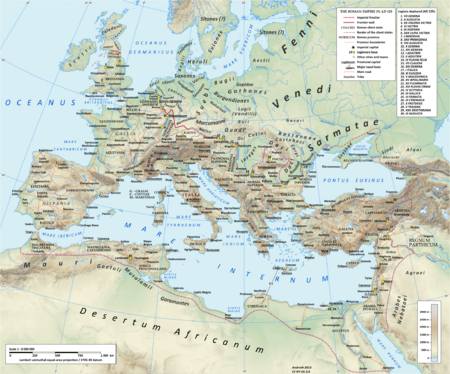Roxolani facts for kids

The Roxolani were an ancient group of people called Sarmatians. They lived a long time ago, from about 200 BC to 400 AD. They first lived near the Dnieper River and the Sea of Azov. Later, they moved closer to the Roman lands of Dacia and Moesia. Many people think they were related to another group called the Alans.
Contents
What Does Their Name Mean?
The name Roxolani likely comes from the Alanic language. It combines the word rox- (meaning 'light' or 'shining') with the name Alān. So, Roxolani probably means the 'shining Alans'.
This name might have been linked to their beliefs. For example, in the modern Ossetian language (which is related to Alanic), rūxsag ū means 'may you be blessed'.
Where Did the Roxolani Live?
The Roxolani first lived in an area between three big rivers: the Volga, the Don, and the Dnieper. In the 1st century AD, they moved west. They settled near the Danube River, in what is now the Baragan steppes in Romania.
A Look at Roxolani History
Roxolani in the 1st Century BC
Around 100 BC, the Roxolani invaded Crimea. Their king, Tasius, supported a Scythian leader named Palacus. However, they were defeated by Diophantus, a general working for Mithradates VI.
Roxolani in the 1st Century AD
In the middle of the 1st century AD, the Roxolani started raiding across the Danube River. They attacked Roman lands. In AD 68 or 69, a Roman army stopped one of their raids. This Roman force included the Legio III Gallica and other Roman soldiers. They defeated 9,000 Roxolanian cavalry riders.
The Roman writer Tacitus said that the Roxolani princes wore heavy armor. This made it hard for them to get back up if they fell during a fight. Their main weapon was a long lance called a kontos. It was hard to use in these conditions.
The Roxolani got their revenge in AD 92. They joined forces with the Dacians and destroyed the Roman Legio XXI Rapax.
Roxolani in the 2nd Century AD
During Trajan's Dacian Wars, the Roxolani first fought alongside the Dacians. They provided most of the Dacian cavalry. But they were defeated in the first war (AD 101–102) at Nicopolis ad Istrum.
They seemed to stay neutral during Trajan's final war (AD 105–106). This war ended with the complete defeat of the Dacian state. The Romans then created the province of Dacia. This brought Roman power right to the Roxolani's doorstep.
Emperor Hadrian strengthened Roman forts along the Danube River. This was to protect against the Roxolani. Later, Emperor Marcus Aurelius also fought against the Roxolani along this border.
Roxolani in the 3rd Century AD
The Roxolani attacked the Roman Province of Pannonia in 260 AD. Not long after this, some Roxolani soldiers joined the Roman army.
Roxolani in the 4th Century AD
Like other Sarmatian groups, the Roxolani were conquered by the Huns. This happened in the middle of the 4th century AD.
Roxolani Culture and Lifestyle
The ancient Greek-Roman historian Strabo described the Roxolani as "wagon-dwellers." This means they were nomads. They moved from place to place in wagons, rather than settling in one spot. He also said they were the most distant of the Scythian peoples.
See also
 In Spanish: Roxolanos para niños
In Spanish: Roxolanos para niños

